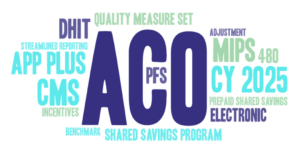Spurred by the COVID-19 pandemic, on August 3rd CMS released a rule proposing changes to the Quality Payment Program (QPP). The previously-announced MIPS Value Pathways (MVPs) have been postponed and replaced by a new APM Performance Pathway (APP) reporting option in 2021 to align with the MVP framework. As part of the APP introduction, the agency will also be sunsetting the CMS Web Interface as a collection type for groups and virtual groups beginning with the 2021 performance period. The APP, like an MVP, would be composed of a fixed set of measures for each performance category. You can see specifics on pages 15 and 16 of the Fact Sheet.
How This Affects Vendors
For the 2021 performance year, CMS proposes to discontinue the Web Interface as a reporting option. It is important to note that the Web Interface serves as a data submission mechanism specifically designed for Accountable Care Organizations (ACOs) and clinical groups comprising 25 or more clinicians. Don’t confuse this with the manual upload of quality data through the QPP website.

Customers who, in prior years manually uploaded QRDA III files will be able to continue. Groups and virtual groups with 25 or more clinicians will have to use one of these alternative submission mechanisms:
- QPP Application Programming Interface (API) This requires specialized software that can interact with the QPP API. Specifications can be found here.
- Qualified Clinical Data Registry (QCDR) – These are typically specialty organizations like the American Academy of Ophthalmology or Pathologists Quality Registry but may also be run by HIEs or other entities.
- Qualified Registry – Many types of organizations feature Qualified Registries, including software vendors, billing services, and independent entities. Dynamic Health IT (DHIT) is a Qualified Registry and we can report your eCQMs and MIPS measures through the QPP API, ensuring you are eligible for the end-to-end bonus.
CMS also introduced a proposal to reduce the total number of MIPS quality measures to 206 for the 2021 performance period. The remaining measures will undergo numerous changes, including:
- Substantive changes to 112 existing MIPS quality measures;
- Changes to specialty sets; for example, CMS147 “Preventive Care and Screening: Influenza Immunization” and CMS127 “Pneumococcal Vaccination Status for Older Adults” were added to several specialty measure sets, including Cardiology and Endocrinology.
- Removal of measures from specific specialty sets;
- The MIPS CQM changes will require programming changes. DHIT is typically one of the first vendors to incorporate new versions of Cypress (the benchmark tool for CQMs) and to support the latest MIPS quality measure definitions.
In the QPP proposed rule, CMS introduces an optional new measure for bi-directional health information exchange that could reduce reporting burdens for clinicians, but it would require them to query for and receive health information from an HIE for all new and existing patients. MIPS providers can use CEHRT to exchange CCDAs with the HIE or they can use API technology cited in the 21st Century Cures Act final rule to exchange USCDI.
With our TIE interface engine, certified ConnectEHR software, and certified FHIR API, we have the tools and expertise to set up a bi-directional interface to your HIE of choice.
Other Provider Impacts
CQM Benchmarks: Traditionally, CMS has established benchmarks using data from the performance period two years prior to the current one. Thus, for 2021 they would have used 2019 performance data. However, due to COVID-19, providers have been given the flexibility to skip 2019 reporting, so CMS is worried that the data may be skewed. For this reason, they plan to use 2021 data to calculate 2021 benchmarks.

This means that providers won’t have a more precise target than the 2020 benchmarks as they prepare to submit 2021 quality measures.
Advanced Alternative Payment Models (APMs): Previously, CMS had introduced the concept of MIPS Value Pathways (MVPs) which align activities from the four MIPS performance categories around a medical specialty, condition, or patient population. MVPs were supposed to roll out for 2021 but with the impact of the pandemic, CMS is delaying this until at least 2022 and, as an interim solution, offering APM Performance Pathways (APPs) in 2021.
The APP is like a “one size fits all” MVP in that there’s a fixed set of measures to report without any specialization. Cost will be weighted at 0% in the APP. All participants in the APP will report on the same set of six measures, shown below:

To cap things off, CMS introduced some minor scoring changes:

So there you have it! Proposed changes to QPP for 2021. As always, CMS would like to get your feedback and comments are being accepted through October 5th.




